Ready to make your kitchen look fabulous without spending too much money? You can choose from either cabinets or cupboards to see which is best for you. Interestingly, people often use words such as cupboards and cabinets interchangeably, but they have some subtle differences.
Whether you are redoing your kitchen, rearranging your bedroom, or setting up a home office, knowing about cupboards and cabinets can make a big difference in how your space looks and works.
In the realm of kitchen design, both ‘cabinet’ and ‘cupboard’ are terms widely used to describe enclosed storage solutions, and the distinction between them is not always seen as crucial.
In this blog, we will decode the key differences in design, functionality, and materials of cupboards vs. cabinets to help you make informed decisions. Also, we will dive deeper into various cabinet options. By the end of this article, you will have a clear idea of which storage option is best for your home.
What is a Cupboard?
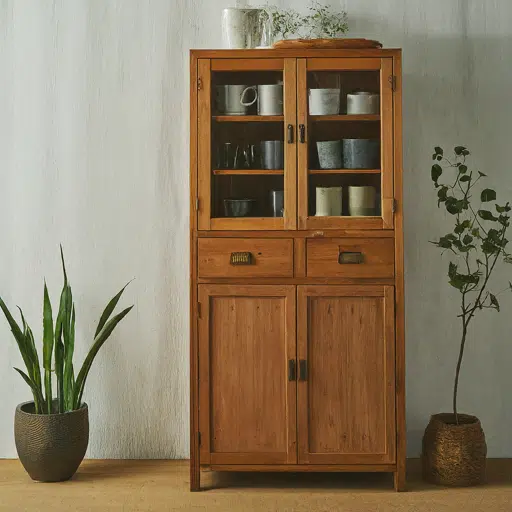
A cupboard, or more specifically, kitchen cupboards, are storage furniture pieces primarily utilized for organizing everyday items such as dishes, tablecloths, or extra towels.
Similar to cabinets, kitchen cupboards typically feature shelves or drawers enclosed behind doors, serving to keep the stored items clean and organized, with shelves specifically designed for storing dishes and pantry items. These units are commonly constructed from wood, although alternative materials like plastic or metal can also be employed.
When choosing kitchen cupboards, focusing on their functionality and aesthetics is essential. Kitchen cupboards typically feature shelves or drawers enclosed by doors, providing ample storage space for various items, including dishes. Here are a few main aspects to consider when opting for Cupboards
Design and Function
The design elements of cupboards can vary widely, from traditional to modern styles, with different materials like wood species or laminates used in their construction. This piece of furniture serves as a functional storage solution with doors and shelves, commonly utilized for housing various items such as kitchen utensils, dishes, or apparel.
Materials and Construction
Cupboards are made from materials like wood, particleboard, or MDF and finished with paint, laminate, or wood veneer to suit your living space. Real wood is durable and long-lasting compared to particleboard or MDF, which may warp in damp conditions. Solid wood cabinets can last for years with proper care, adding value to your home.
Natural Beauty and Aesthetics
Real wood’s inherent allure and warmth are a primary incentive for homeowners to opt for wooden cupboards. Wood’s distinctive grain patterns, color variations, and textures impart a timeless and welcoming ambiance that is challenging to replicate with synthetic materials.
Versatility and Customization
Actual wood cupboards offer unparalleled versatility in terms of design and customization. Unfinished cupboards can be stained or painted in many hues to complement your home’s interior, while a wide array of wood species such as oak, maple, cherry, or walnut afford options to achieve the desired aesthetic. Furthermore, solid wood can be easily tailored or refinished if you wish to update your home’s décor.
Types of Cupboards Including Pantry Cupboard
There are three primary categories of cupboards: airing, built-in, and linen cupboards. Let’s delve into each of them:
Airing Cupboards
Airing cupboards are versatile storage units mainly for heating system components and drying textiles like towels. With slatted shelves for airflow, they prevent dampness and mold. Placed in utility rooms or near bathrooms, airing cupboards maintain system functionality and keep textiles fresh.
Built-in Cupboards
Built-in cupboards are seamlessly integrated storage solutions tailored to room design. Configured with shelves, drawers, and hanging rods made of durable materials like wood or MDF, they enhance room functionality while complementing its aesthetic.
A pantry cupboard is a specialized type of enclosed kitchen space, designed with ample shelves and space for efficiently storing food items and serving items like cups, plates, and saucers. It serves a distinct purpose from other cupboard types by focusing on kitchen storage needs, resembling a closet in its design and functionality.
Linen Cupboards
Linen cupboards are storage spaces for organizing household textiles like linens, towels, and bedding. They are also ideal to store extra towels, providing efficient storage and access to linens that are not needed every day. With shelves, drawers, and compartments, linen cupboards offer centralized storage. Placed strategically in bedrooms, bathrooms, or hallways, they serve as a practical solution for extra storage needs. They often feature design elements like glass-fronted doors for aesthetic appeal and practicality.
What is a Cabinet?
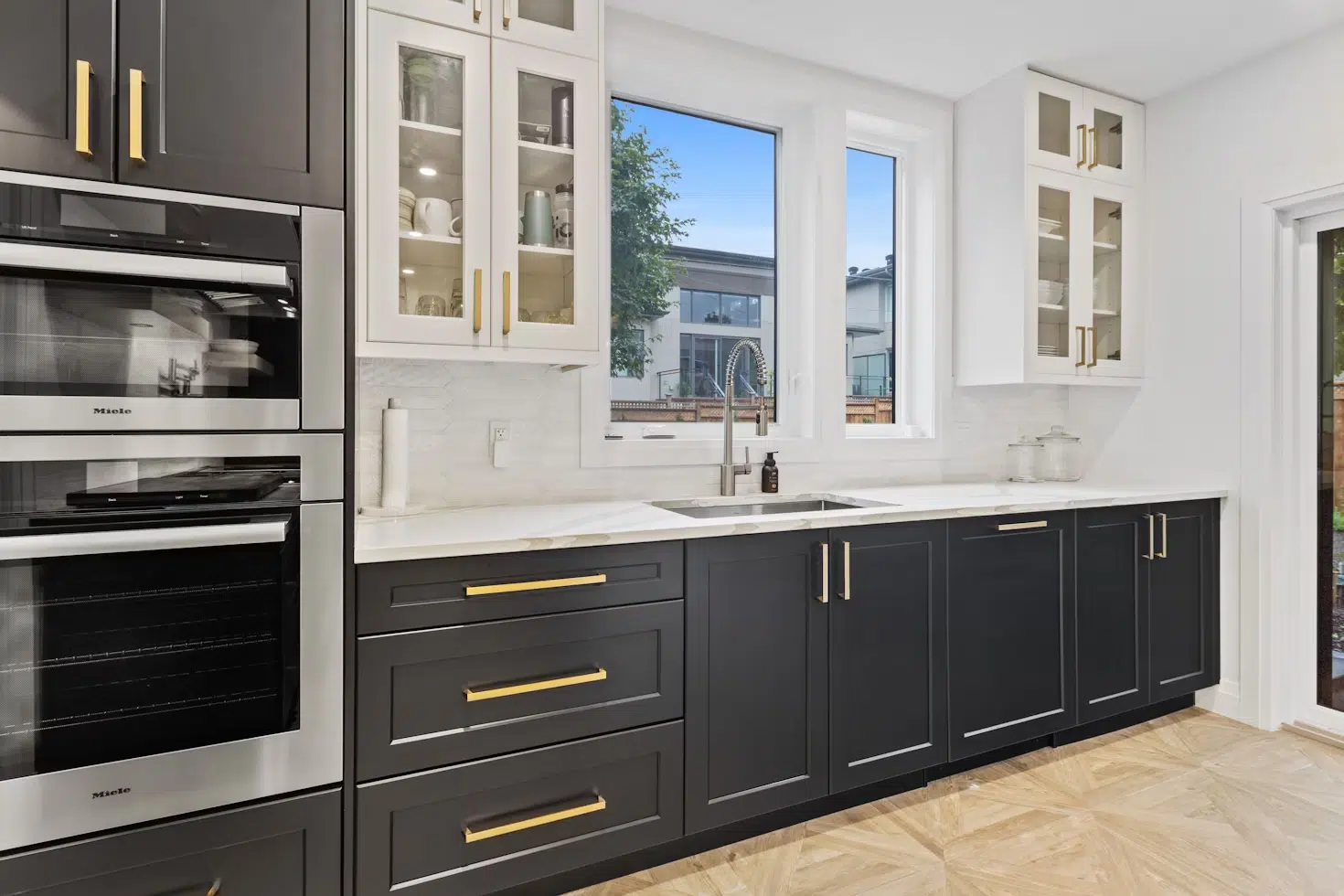
A cabinet is a storage unit with doors, shelves, and drawers made from wood, metal, or plastic. They are commonly used in kitchens and bathrooms but can be placed in any space for extra storage. Cabinets provide concealed storage for cooking and baking necessities, and are also suitable for dining rooms for displaying dinnerware and providing additional storage. Size, style, and functionality are key factors when choosing a cabinet.
Design and Function
Cabinets are stylish and intricately crafted furniture used for storage and display. They often feature glass doors, decorative moldings, and intricate hardware to enhance the visual appeal of their space.
Materials and Construction
Cabinet makers prioritize precision and quality in construction techniques, using materials like plywood, MDF, or solid wood species such as cherry or maple for durability. Craftsmanship is crucial in every aspect, from designing cabinet doors to assembly. Attention to detail, particularly in corners and nooks, ensures a flawless finish that enhances the cabinets’ overall look.
Natural Beauty and Aesthetics
Cabinets display the innate beauty of solid wood or bamboo by featuring distinct grain patterns and vibrant colors. Protective clear varnishes and stains enrich these natural tones and safeguard the material. Incorporating nature-inspired elements establishes a deeper connection to the environment, promoting a sense of peace and balance within the surroundings.
Versatility and Customization
Cabinets are versatile and suit various design styles, from modern to traditional. Customization options include decorative molding, unique hardware, and personalized door designs. With various colors and hardware choices, cabinets can be personalized to match individual preferences, enhancing any space.
Varieties of Cabinets: Cabinets come in various forms, including:-
European-style Kitchen Cabinets with Glass Doors
European-style kitchen cabinets are sleek and modern, known for their clean lines, minimal ornamentation, and frameless construction. They use high-quality materials and innovative storage solutions, perfect for modern kitchens.
RTA European Flat Panel
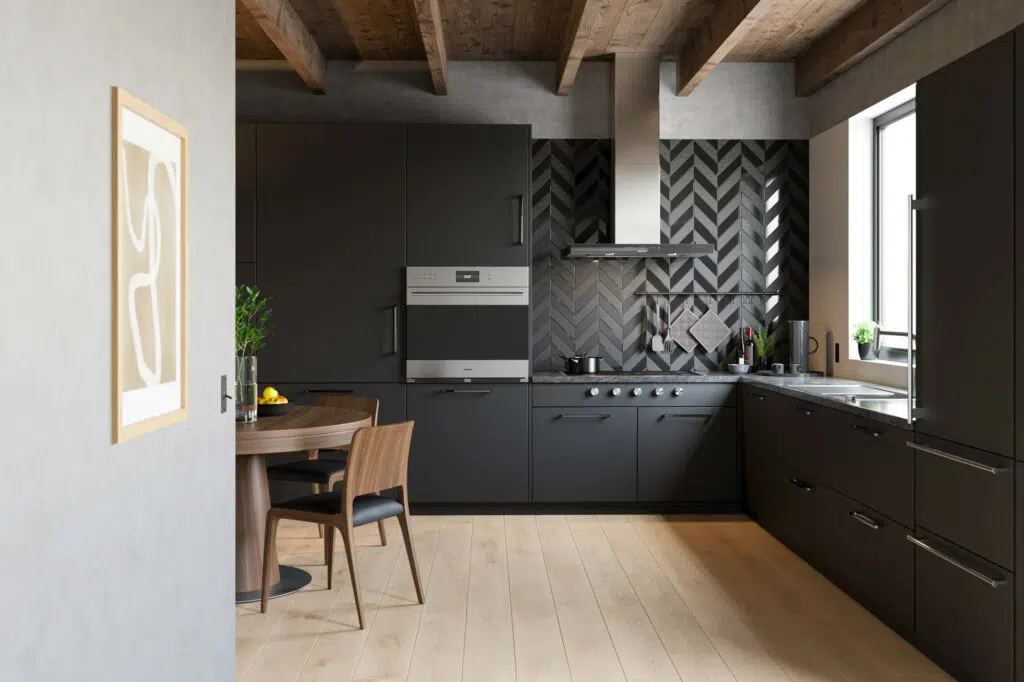
RTA cabinets are shipped unassembled for easy assembly upon delivery. European flat panel cabinets have a smooth surface without raised or recessed panels, adding a modern touch to European kitchen designs.
Also Read: The Best RTA Cabinets for Your Dream Kitchen
Assembled Semi-Custom Cabinets
Semi-custom cabinets offer convenience and customization, with partial pre-assembly and options in size, materials, finishes, and accessories. Homeowners can personalize these cabinets to meet their needs without the long wait times of fully custom cabinets.
Shop Cabinets By Style
This point suggests that customers can browse and purchase cabinets based on their preferred style. Whether they’re looking for European, shaker, or other styles, this approach makes it easier for customers to find cabinets that match their desired aesthetic for their kitchen design.
Shaker Style Cabinets
Shaker cabinets have a classic look with simple, clean lines. They feature a five-piece door with a recessed center panel, adding traditional elegance to any kitchen. They are versatile and suitable for modern, transitional, or farmhouse styles.
Also Read: What are shaker kitchen cabinets?
Solid Wood Kitchen Cabinets
Solid wood kitchen cabinets are valued for their durability, natural beauty, and timeless appeal. Made entirely of wood without veneers or particleboard, they guarantee longevity and strength. These cabinets can be finished in different stains or paints to highlight the natural grain and color of the wood, bringing warmth and character to your kitchen.
Inset Kitchen Cabinets
Inset kitchen cabinets feature doors and drawers set into the cabinet frame, creating a flush surface when closed. This precise craftsmanship results in a seamless and elegant look, offering a classic and timeless aesthetic for traditional and transitional kitchen designs.
Based on colors:
White Kitchen Cabinets
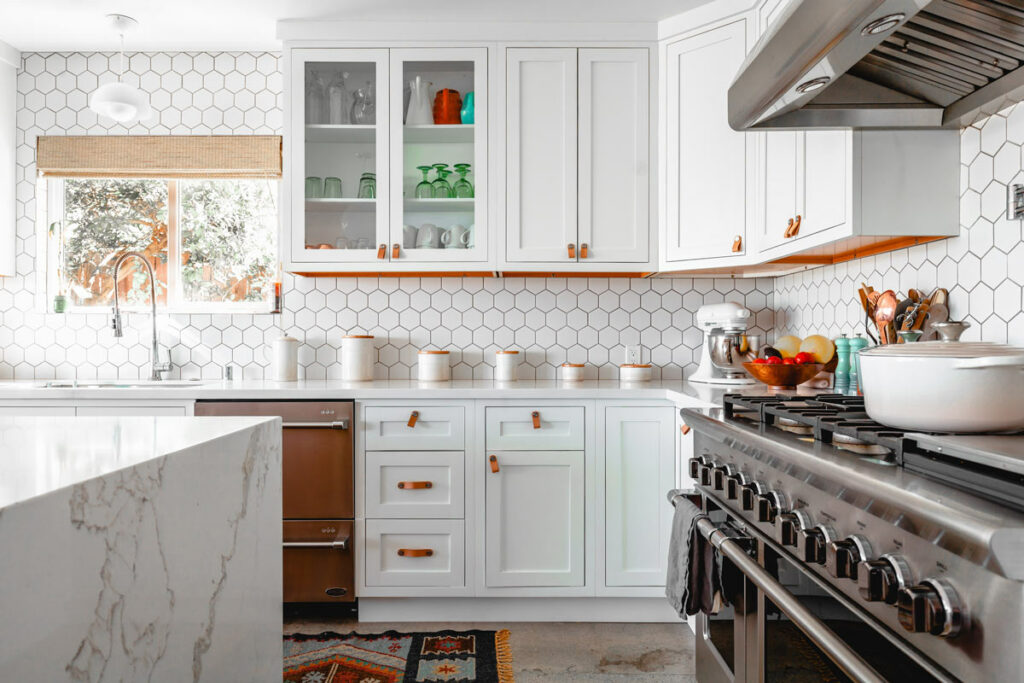
White kitchen cabinets are timeless and versatile, making them a popular choice for many homeowners. White Kitchen Cabinets brighten up the space, making it appear larger and more open, and they also provide a neutral backdrop that pairs well with a wide range of colors and finishes for countertops, backsplashes, and hardware.
Also Read: WHITE KITCHEN CABINETS: Classic and Timeless
Gray Kitchen Cabinets
Gray kitchen cabinets provide a modern alternative to white cabinets, with shades ranging from light to dark; gray offers versatility in creating different kitchen aesthetics. Pair them with various countertops for a contemporary or transitional look.
Black Kitchen Cabinets
Black kitchen cabinets add drama and elegance to the kitchen, creating a bold statement. They offer a striking contrast against lighter elements, enhancing both modern and traditional aesthetics based on the cabinet style and surrounding decor.
Difference between Cupboards and Cabinets
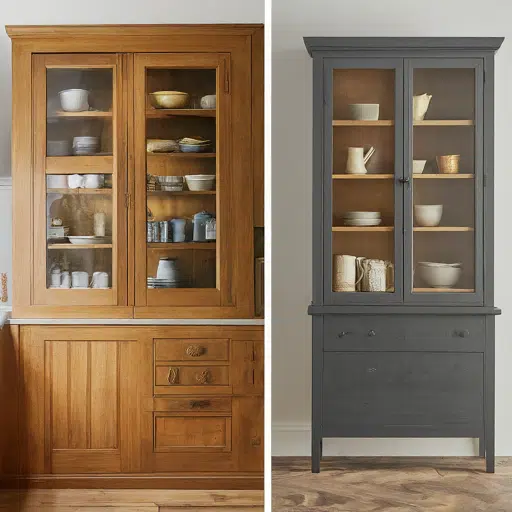
Size
As mentioned before, cupboards are a type of cabinet that is typically small when built into a wall. They are equipped with shelves for holding dishes, cups, or pantry items. Think of a cupboard in the pantry for snacks or in a bedroom for storing clothes.
Purpose
Cupboards are strategically located in homes to hide items from view and offer extra storage space. They can be used to store spare towels in the bathroom or organize additional sheets in a guest room for items used sparingly.
On the other hand, complete and overlay cabinets focus on accessibility, making essential items like kitchen utensils or bathroom toiletries easily reachable. These cabinets usually have one or more doors to keep things private.
Shape
Cabinets in bathrooms and kitchens usually have square or rectangular shapes, sometimes with arches for certain design styles. On the other hand, cupboards are taller and more rectangular than standalone furniture or shorter and more comprehensive for spaces like media rooms or entryways.
Construction
Cabinets, typically made of wood but sometimes using metal or plastic, often include doors, shelves, or drawers for arranging daily items. Cupboards likewise have comparable elements such as doors, shelves, and drawers, utilizing various construction materials, from wood and metal to plastic, stainless steel, or melamine.
Aesthetic Appeal
Cabinets frequently showcase elaborate designs and glossy finishes, making them eye-catching centerpieces in any space. On the other hand, cupboards usually feature a more practical look, prioritizing functionality over decoration.
Choosing Between Cupboard and Cabinet: Making The Right Choice For Your Space
Whether it’s for your kitchen or any other room, understanding the distinct differences in design and usage will help you make the perfect choice for your space.
Assessing Your Needs and Space
Consider your storage needs, functionality, and aesthetic preferences when choosing between cupboards and cabinets. Evaluate factors like kitchen design, material durability, and storage requirements to make an informed decision that effectively complements your space.
Budget Considerations
When choosing your space, budget for quality and style. Assess your needs and space to allocate funds wisely. Consider durability, workmanship, and materials. Quality cabinets reflect your style preference. Balancing quality and style is key in selecting the best option for your home or office. Evaluate your budget and choose based on aesthetic and practical needs.
Matching Your Home Décor
When choosing between a cabinet and a cupboard, consider your living space’s existing home decor style and atmosphere. A cabinet may suit a traditional or ornate design, while a cupboard complements a minimalist or modern aesthetic.
Conclusion
Understanding the differences between cupboards and cabinets can assist in making well-informed decisions about organizing your space. Cupboards offer traditional charm and accessibility, while cabinets provide modern functionality and style. Evaluate your needs, budget, and space to select the best option.
Whether you prefer European-style cabinets or solid wood cupboards, ensure durability, craftsmanship, and customization match your preferences. Explore storage solutions confidently, recognizing the unique qualities that differentiate cupboards and cabinets.
Frequently Asked Questions
Are Cabinets & Cupboards the Same Thing?
Cabinets and cupboards differ in design and function. While cupboards often have open shelves or are used for storage, cabinets typically feature doors and may serve various purposes. Understanding these distinctions helps you choose the right storage solution for your space.
Are Cupboards Always Less Expensive Than Cabinets?
Cupboards are generally less expensive than cabinets due to their more straightforward designs and materials. However, factors like quality, customization, and brand can influence pricing. Understanding your needs and budget is crucial in deciding between the two.
Do Cupboards And Cabinets Need Maintenance?
Yes, you should clean them sometimes and fix anything broken. That helps them last longer.
Can I Use a Cupboard or Cabinet For Something Else?
Yes, you can change them to fit different rooms or jobs, like turning a kitchen cabinet into a cool bathroom shelf.





